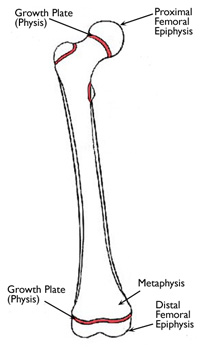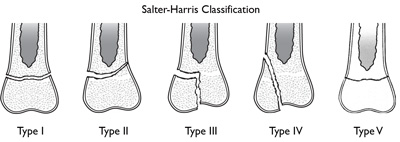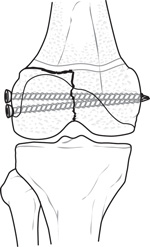
Growth Plate Fractures
Information on growth plate fractures is also available in Spanish: Fracturas del cartílago de crecimiento.
The bones of children and adults share many of the same risks for injury. But because they are still growing, a child's bones are also subject to a unique injury called a growth plate fracture. Growth plates are areas of cartilage located near the ends of bones. Because they are the last portion of a child's bones to harden (ossify), growth plates are particularly vulnerable to fracture.
Approximately 15% to 30% of all childhood fractures are growth plate fractures. Because the growth plate helps determine the future length and shape of the mature bone, this type of fracture requires prompt attention. If not treated properly, it could result in a limb that is crooked or unequal in length when compared to its opposite limb. Fortunately, serious problems are rare. With proper treatment, most growth plate fractures heal without complications.
AnatomyGrowth plates are found in the long bones of the body—the bones that are longer than they are wide. Examples of long bones include the femur (thighbone), the radius and ulna in the forearm, as well as the metacarpal bones in the hands.
Most long bones in the body have at least two growth plates, including one at each end. Growth plates are located between the widened part of the shaft of the bone (the metaphysis) and the end of the bone (the epiphysis). The long bones of the body do not grow from the center outward. Instead, growth occurs at each end of the bone around the growth plate. When a child is fully grown, the growth plates harden into solid bone.
 This diagram of a femur (thighbone) shows the location of the growth plates at both ends of the bone.
Reproduced with permission from Sullivan JA: Introduction to the Musculoskeletal System, In Sullivan JA, Anderson SJ (eds): Care of the Young Athlete, Rosemont, IL, American Academy of Orthopaedic Surgeons and American Academy of Pediatrics, 2000, pp 243-258.
Description
This diagram of a femur (thighbone) shows the location of the growth plates at both ends of the bone.
Reproduced with permission from Sullivan JA: Introduction to the Musculoskeletal System, In Sullivan JA, Anderson SJ (eds): Care of the Young Athlete, Rosemont, IL, American Academy of Orthopaedic Surgeons and American Academy of Pediatrics, 2000, pp 243-258.
Description
Most growth plate fractures occur in the long bones of the fingers. They are also common in the outer bone of the forearm (radius) and lower bones of the leg (the tibia and fibula).
Classification of Growth Plate Fractures
Several classification systems have been developed that categorize the different types of growth plate fractures. Perhaps the most widely used by doctors is the Salter-Harris system, described below.
Type I Fractures
These fractures break through the bone at the growth plate, separating the bone end from the bone shaft and completely disrupting the growth plate.
Type II Fractures
These fractures break through part of the bone at the growth plate and crack through the bone shaft, as well. This is the most common type of growth plate fracture.
Type III Fractures
These fractures cross through a portion of the growth plate and break off a piece of the bone end. This type of fracture is more common in older children.
Type IV Fractures
These fractures break through the bone shaft, the growth plate, and the end of the bone.
Type V Fractures
These fractures occur due to a crushing injury to the growth plate from a compression force. They are rare fractures.
 Salter-Harris classification of growth plate fractures.
Cause
Salter-Harris classification of growth plate fractures.
Cause
Growth plate fractures are often caused by a single event, such as a fall or car accident. They can also occur gradually as a result of repetitive stress on the bone, which may occur when a child overtrains in a sports activity.
All children who are still growing are at risk for growth plate injuries, but there are certain factors that may make them more likely to occur:
- Growth plate fractures occur twice as often in boys as in girls, because girls finish growing earlier than boys.
- One-third of all growth plate fractures occur during participation in competitive sports such as football, basketball, or gymnastics.
- About 20% of all growth plate fractures occur during participation in recreational activities such as biking, sledding, skiing, or skateboarding.
- The incidence of growth plate fractures peaks in adolescence.
A growth plate fracture usually causes persistent or severe pain. Other common symptoms include:
- Visible deformity, such as a crooked appearance of the limb
- An inability to move or put pressure on the limb
- Swelling, warmth, and tenderness in the area around the end of the bone, near the joint
Because a child's bones heal quickly, a potential growth plate injury should be examined by a doctor as quickly as possible, ideally within 5 to 7 days. It is important that the bone receives the proper treatment before it begins to heal.
After discussing your child's symptoms and medical history, your doctor will perform a careful physical examination of the injured area.
Your doctor will likely order an x-ray to determine whether a growth plate fracture has occurred. X-rays provide clear images of dense structures, such as bone. If greater detail is needed, your doctor may order other diagnostic imaging tests that can better show the soft tissues, or a cross-sectional view of the injured area. These types of scans include magnetic resonance imaging (MRI) scans and computed tomography (CT) scans.
TreatmentTreatment for growth plate fractures depends on several factors, including:
- Which bone is injured
- The type of fracture
- How much the broken ends of the bone are out of alignment (displaced)
- The age and health of the child
- Any associated injuries
Nonsurgical Treatment
 This Type III fracture of the thighbone (femur) goes through the growth plate and down into the knee joint. The fracture is fixed with screws. This restores normal joint alignment.
This Type III fracture of the thighbone (femur) goes through the growth plate and down into the knee joint. The fracture is fixed with screws. This restores normal joint alignment.
Many growth plate fractures can heal successfully when treated with immobilization: a cast is applied to the injured area and the child limits some types of activity.
Doctors most often use cast immobilization when the broken fragments of bone are not significantly out of place. A cast will protect the bones and hold them in proper position while they heal.
Surgical Treatment
If the bone fragments are displaced and the fracture is unstable, surgery may be necessary. The most common operation used to treat fractures is called open reduction and internal fixation.
During the procedure, the bone fragments are first repositioned into their normal alignment (called a reduction). The bones are then fixed into place with special implants like screws or wires, or by attaching metal plates to the outer surface of the bone.
A cast is often applied to protect and immobilize the injured area while it heals.
ComplicationsAlthough most growth plate fractures heal without any lasting effect, complications can occur.
Rarely, a bony bridge will form across the fracture line, stunting the growth of the bone or causing the bone to curve. If this occurs, your doctor may perform a procedure to remove the bony bar and insert fat or other materials to prevent it from reforming.
In other cases, a growth plate fracture may actually stimulate growth so that the injured bone ends up longer than its opposite, uninjured limb. If this occurs, surgery can help achieve a more even length.
RecoveryA child's bones heal quickly, but a growth plate fracture can still take several weeks to heal. If cast immobilization is used, the length of time the cast is worn will vary depending on the severity of the fracture.
After the bone heals, your doctor may recommend specific exercises to strengthen the muscles that support the injured area of bone and improve the range of motion of the joint.
Long-Term OutcomesGrowth plate fractures must be watched carefully to ensure proper long-term results. Regular follow-up visits to the doctor should continue for at least a year after the fracture to make sure that the growth plate is growing appropriately.
More complicated fractures, as well as fractures to the thighbone (femur) and shinbone (tibia), may require follow-up visits until the child reaches skeletal maturity.
Statistical data on this webpage was reviewed by the AAOS Department of Research and Scientific Affairs.
Source: http://orthoinfo.aaos.org/topic.cfm?topic=A00040
